Abstract
The study was conducted to test whether a vigor test of a single count of radicle emergence (RE test) would correlate with the storage potential of 10 seed lots of onion (Allium cepa L.) cultivars in artificial storage conditions. The RE test was performed by counting radicle emergence (2 mm) percentage at 80 h after germination was set up at 20 °C. Seed longevity was determined by storage at 75% relative humidity, obtained by saturated NaCl, at 35 °C over 60 days. Twelve seed samples were taken out during ageing, and seed survival curves were constructed based on normal germination percentages conducted at 20 °C for 12 days in the dark. The seed longevity criterion was P50 (time for the viability to fall to 50%), which was determined through probit analysis by using survival curves. Correlation analysis showed that RE counts at 80 h during germination were highly correlated (p < 0.001) with initial seed quality, Ki (R2 = 0.888) and the half-viability period, P50 (R2 = 0.823). Non-aged pre-storage final normal germination percentages of seed lots were also significantly related to longevity (Ki, R2 = 0.808, p < 0.001, P50, R2 = 0.750, p <0.01), while the level of significance was lower. It can be concluded that the RE test can be used as a fast vigor test to estimate the longevity in onion seed lots.
1. Introduction
Seed quality, specifically germination and vigor, plays a major role in achieving uniform and timely emergence and production of uniform, vigorous seedlings both in the field and in the glasshouse. Seed vigor is a major component of seed quality that gives more information about the seed lots than germination and relates to the field emergence potential and storage longevity of any lot [1,2]. Highly vigorous seed lots are recognized by fast and good stand establishment under various environmental conditions and remain viable for longer periods during storage [1]. Seed vigor tests such as accelerated ageing, controlled deterioration, electrical conductivity, and saturated salt accelerated ageing were found to be related to the seedling emergence percentage and longevity of a seed lot in various species [3,4,5,6,7]. A better seed vigor test is considered to be one that is fast, reproducible, and efficiently discriminates seed lots [3,8]. The radicle emergence (RE) test, the proportion of seeds with a radicle ≥ 2 mm long after a certain length of time in a germination test, was introduced as a fast, easy, and practical vigor test. It has been validated as a vigor test by the ISTA for maize (Zea mays L.), radish (Raphanus sativus L.), wheat (Triticum aestivum L. subsp. aestivum), and oil seed rape (Brassica napus L. subsp. napus) [9]. The philosophy behind the RE test is based on the lag period between the start of imbibition and radicle emergence of about 2 mm [10]. In physiologically, seed lots that are aged or of low vigor, this period is longer due to the need for more time for metabolic repair, and the radicles emerge later than those of physiologically young seed lots. The RE test has, until now, been related to the seedling emergence of diverse species in the field or modules [6,11,12,13,14,15,16]. However, there are few studies on its use in the prediction of seed longevity. For example, 48 h RE counts during germination in violas [5] and petunias [7], 120 h in leeks [17], and more recently, 30–34 h in cucurbit rootstock seed (Cucurbita maxima Duch. x Cucurbita moschata Duch.) lots [18] were found to be related to seed longevity during artificial ageing. Maintaining seed viability from harvest to sowing is a major issue faced by seed producers, particularly in those species that rapidly lose viability during storage, particularly when storage facilities are adverse, such as onions [19]. Demir and Ozcoban [20] indicated that significant seed viability loss occurred in onion seeds at 20 °C with 6.2% seed moisture over five years. Seeds with high seed oil contents, such as onions, were proposed as one reason for shorter longevity [21]. Our laboratory found that the RE test predicted normal germination percentages of 20 cultivars and genotypes of onions after 12 days at 20 °C, and 80 h of RE was found to be highly predictive of normal germination percentages (p < 0.001, R2 = 0.95) [7].
Seed deaths in a population over time show a normal distribution during storage. Thus, the determination of the time for germination to fall to 50%, P50, is a good indicator of seed longevity of any seed population or lot [22,23]. In this work, we examined whether the RE test (80 h) predicts longevity by the P50 (half-viability period) values of onion seed lots.
2. Materials and Methods
A total of ten accessions of cultivar seed lots (Allium cepa L. var. cepa.) were obtained from different seed companies. The onion accessions were Ambrossa (lots 1, 2, and 3), Elit (lot 4, 6, and 7), Damla (lots 5, 8, and 10), and Hazar (lot 9). The seed lots were kept hermetically sealed at 4 ± 1 °C before they were used. The initial moisture content of the seeds was determined by comparing their fresh weight to their oven-dried weight (103 °C for 17 h) according to the ISTA [9]. There was a range of 7.14 to 8.19% moisture content in the onion seed lots before the experiment was started.
To study longevity, about 1800 seeds of each lot were equilibrated to 75% relative humidity in plastic containers (36 cm long x 18 cm wide x 12 cm deep) by placing them on top of wire mesh over saturated NaCl solution at room temperature in the dark. This solution was prepared by using a ratio of 400 g of NaCl to 500 mL of water. Seed moisture contents were stabilized between 11.7 and 12.1% by keeping seeds at over 75 percent relative humidity (Table 1). The proper seed moisture content was established at room temperature by weighing seeds frequently until weight stabilization. The plastic containers were then placed in a germination chamber set at 35 ± 2 °C. The following formula was used to determine the final seed moisture content (mc) of the lots using the initial seed weight and moisture:
Seed weight at desired mc = (100 − initial mc)/(100 − desired mc) × weight of seed

Table 1.
Characteristics of the ten onion (Allium cepa L.) seed lots used in the study: total germination (TG; %), normal germination (NG; %), seed moisture content (mc; %), and RE test count (%) at 80 h.
After 12 different aging periods of 0, 3, 7, 10, 14, 21, 24, 28, 35, 42, and 60 days, one sample of 150 seeds from each lot was taken from the plastic containers after waiting a few seconds. Germination of the seed lots was examined for three replicates of 50 seeds per lot (Figure 1). Then each lot of seeds was germinated on moist rolled paper towels (20 × 20 cm Filtrak, GmBH, Germany) at 20 °C in the dark. A plastic bag was placed over the rolled papers before the germination test in order to prevent water loss. These papers were moistened as needed. Radicle emergence test counts (RE, assessed as production of a 2 mm long radicle) were made at 80 h after sowing. The percentage of total seedlings was calculated after 12 days [9]. Survival curves were constructed based on normal germination. The survival curves were then examined using probit analysis as described by Ellis and Roberts [22], and De Vitis et al. [24]. The seed viability equation, as shown below, was used to calculate the rate of seed deterioration:
where V is the viability after p days in storage at a given seed moisture and temperature. To measure the initial seed quality (combination of effects from genetic and environmental factors on quality), Ki, it is the intercept on the probit viability axis before storage. The loss of viability is normally distributed in time; therefore, it can be quantified in terms of P50, the half-viability period, or σ, the standard deviation of seed deaths in time (i.e., the time required to lose 1 probit of viability) at a certain seed moisture and storage temperature. Since percentages must be transformed into probit values, the arch-sin transformation was not used.
V = Ki − p/σ
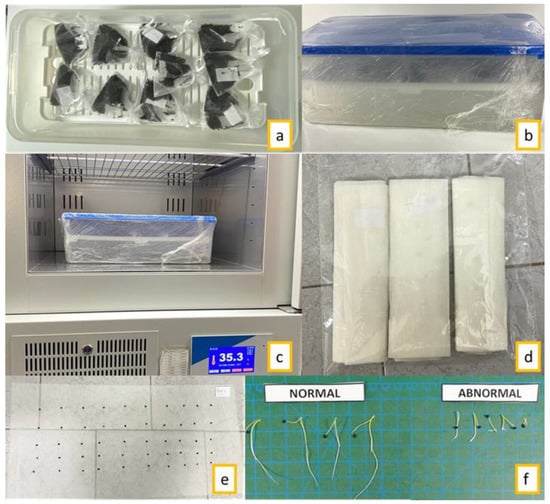
Figure 1.
(a,b): onion seed lots were put into plastic containers for 75% relative humidity, (c) the plastic containers were placed in a germination chamber set at 35 ± 2 °C, (d,e) each lot of seeds was rolled in paper towels, (f): normal and abnormal onion seedlings.
Germination tests were carried out with a completely randomized design to establish the laboratory tests in this study. The mean and the standard error (SE) were calculated, and differences in the means were considered to be significant (p < 0.05). The SPSS (IBM SPSS 21 program package) statistical program was used for these analyses. Correlation coefficient values were calculated between RE 80 h counts, pre-storage normal germination percentages and Ki and P50 values, RE 80 h pre- and post-storage of 7, 14, and 21 days after storage, and significance was evaluated at the 0.05 and 0.001% level.
3. Results
The total germination capacity of the ten onion seed lots ranged from 85 to 99%. However, the percentage of normal seedlings in the seed lots varied from 75 to 89%. A typical germination percentage of 75% was achieved by all seed lots, which was the minimum standard for commercial use. The moisture content of seeds during storage was very close and ranged between 11.7 and 12.1% (Table 1). The RE 80 h values showed that the germination of seed lots was between 71 and 91%. However, onion lots 7, 8, 9, and 10 were the slowest germinators.
The seed survival curves of ten onion seed lots are presented in Figure 2. The survival curves (normal germination percentage plotted against storage period) of the ten onion seed lots showed the typical sigmoidal pattern.
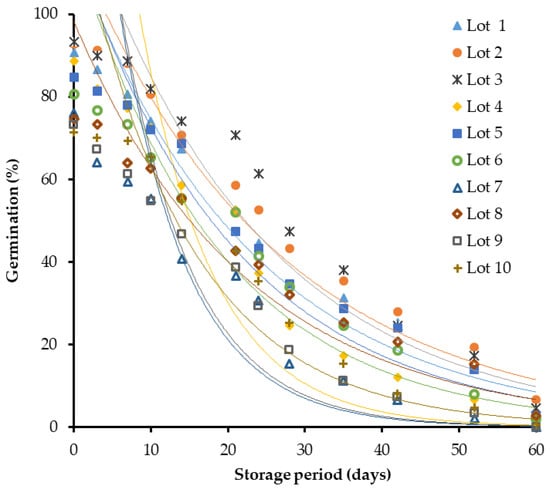
Figure 2.
Survival curves of the seeds of ten onion (Allium cepa L.) seed lots stored at 35 ± 2 °C and 75% relative humidity over 60 days.
Seed germination losses in lots 6, 7, 8, 9, and 10 were much faster in earlier sampling times of the storage than in the other lots (Table 2). The estimated Ki is also low for these five lots. The greatest value of Ki was obtained from Lot 2 and Lot 3 as 1.36 and 1.46 (probit value), respectively. The minimum Ki value was obtained from Lot 7 and Lot 9, and the other lots were placed within similar values. According to the P50 and sigma, shorter longevity was associated with lower Ki values (Figure 3). The viability loss was slower (σ) in lot 3, lot 4, and lot 7 but was higher in lot 8. There were no differences in σ values in the other seed lots.

Table 2.
Probit model parameters (standard error of the mean) for seed lots of ten onion (Allium cepa L.) seed lots stored aged with NaCl at 35 ± 2 °C.
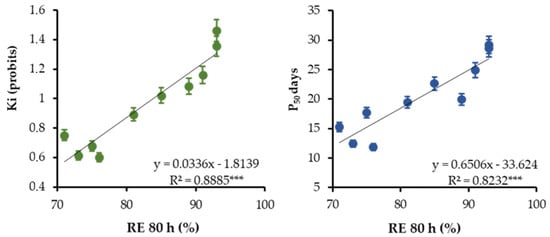
Ki values varied between 0.60 and 1.46 as probit values. Mean P50 values ranged between 11.8 and 29.2 days. The highest Ki and longest P50 value were seen in the seed on Lot 3. Lot 7 showed the lowest Ki value and the shortest P50 value as days. RE 80 h counts (Table 1) and Ki and P50 (Table 2) were regressed and highly related (Ki p < 0.001, R2 = 0.888, P50 p < 0.001, R2 = 0.823) (Figure 3).
Pre-storage normal germination percentages of onion seed lots were significantly related to the Ki (p < 0.001, R2 = 0.808) and P50 (p < 0.750, R2 = 0.01) values (Figure 4). The regressions of the pre-storage and post-storage RE 80 h values after 7, 14, and 21 days of storage (Figure 5) revealed highly significant coefficients of determination for onions. The significance was R2 = 0.956, p < 0.001 for seeds stored for seven days, R2 = 0.833, p < 0.01 for seeds stored for 14 days, and R2 = 0.686, p < 0.05 for seeds stored for 21 days, indicating that RE 80 h counts decrease as seeds age. The higher pre-storage RE counts were significantly related to those observed after 7, 14, and 21 days of storage.
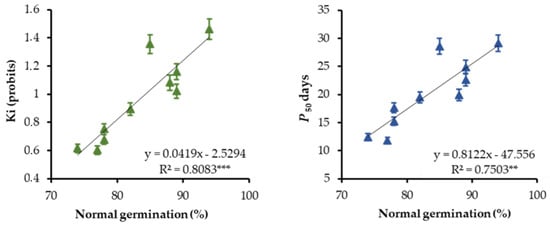
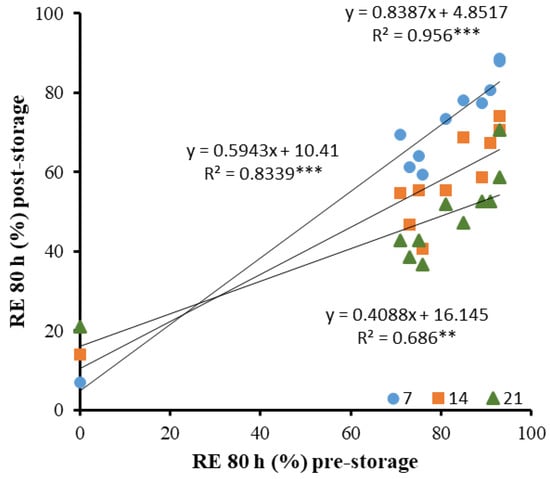
Figure 5.
Correlation between RE 80 h counts of pre- and post-storage after 7, 14, and 21 days. Significance: **: 0.01, ***: 0.001.
4. Discussion
This work aimed to relate the RE count with the storage longevity of seed lots of ten onion cultivars under artificial ageing conditions. The RE test (80 h) correlated well (p < 0.001) with the longevity of the seed lots (Figure 2). Longevity parameters were considered as Ki (initial seed quality) and P50 (half-viability periods). We tested only 80 h of RE count since we found in our earlier work that this count was very successful in predicting normal germination percentages in a large number of onion seed genotypes and cultivars [7].
Seed vigor tests provide more information for seed laboratories and seed companies about seed quality beyond the standard laboratory germination test, particularly when seed germination is high, and they are used to predict both seedling field emergence performance and storage longevity [3,4,5,6,7]. In our work, pre-storage normal germination percentages were also found to significantly (p < 0.01–0.001, R2 = 0.750–0.808) predict longevity (Figure 4). However, the RE test showed higher correlation (p < 0.001, R2 = 0.823–0.888) values than those of pre-storage standard germination percentages (normal germination) (Figure 2 and Figure 3). Most common vigor tests validated by the ISTA [9] as accelerated ageing, controlled deterioration, and saturated salt accelerated ageing are based on ageing tests, which take a long time: a period of storage followed by the germination test evaluation period. Such vigor tests have two basic phases. First, seed moisture is allowed to increase to a predetermined level (i.e., controlled deterioration) or seeds are aged at a certain high relative humidity (i.e., 70–100 RH, accelerated ageing, and saturated salt accelerated ageing) at 40–45 °C for a certain time of 24 or 72 h [8]. Then, a standard laboratory germination test is conducted to rank seed lots according to vigor level. In total, these stages can take a minimum of 13 days (i.e., one day of ageing and 12 days of germination) for onion seeds. When the controlled deterioration test is used, one extra day is needed (14 days) for raising seed moisture and equilibration [4]. Even when the controlled deterioration test is used successfully for predicting the longevity of onion seed lots under commercial [25] and low-temperature storage conditions [4], such a long seed vigor testing time period is laborious and impractical for seed companies and seed technology laboratories that have to run vigor tests for a large number of seed lots at a time and decide about marketing policy within a short time. Therefore, quick, reliable, and easy vigor test methods are helpful and necessary in seed technology, particularly when quick information about the lot is urgently needed. In that way, the RE test has great advantages. Our results on the successful prediction of longevity by the RE test are in agreement with previous reports on various species. Single RE counts of 48 h in violas [5] and petunias [7], 120 h in leeks [17], and more recently, 30–34 h in cucurbit rootstock seed lots [18] were found to be related significantly to seed longevity during artificial ageing. Maintaining seed vigor from harvest to sowing (storage period) is a major challenge for seed producers, particularly in those species such as onions that rapidly lose viability during storage in non-optimum storage conditions [20]. Oily seeds such as onions are proposed to be less resilient to longevity [21].
One of the first indications of aging (vigor loss) in seeds is an extended time between imbibition and appearance of the radicle, and differences in the length of this period have been related to seedling emergence in modules and in field conditions in pepper and maize [26,27]. Therefore, earlier radicle emergence percentages (RE test) of any lot have been proposed as an indicator of the extent to which a seed lot has aged and its seed vigor [10]. Seed lots that need a longer time between imbibition and radicle emergence, as seen in low-vigor lots, are necessary to allow for metabolic repair [28]. In high-vigor lots with physiologically high-quality seeds, the radicle emerges earlier since there is much less ageing-induced damage that needs DNA repair [14].
In this study, we tested longevity in a warm environment with high humidity (75% RH, 35 °C) in artificially arranged conditions. However, seeds in commercial storage are typically maintained at 15–17 °C and 45–60% RH, which are more optimum conditions. Even though ageing will be slower in commercial storage, it may still impact the quality of seed lots in the long run. In our earlier studies, we tested the relationship between the RE test and longevity in artificially aged seed lots in seeds of various species stored at high, fast-ageing [17,18] and low, slow-ageing [5,7] temperatures. Seed storage periods were up to 24 months at 5 °C with 5.5 and 6.4% seed moisture in petunias [7] and over 12 months with 4.5 and 8.3% in viola [5] seed lots. These storage conditions were quite similar to commercial seed storage and active collections in seed gene banks. In such conditions, the RE test was related to longevity at a significant level in violas (p < 0.01, R2 = 0.80–0.86) and petunias (p < 0.05, R2 = 0.76). Some earlier observations showed that the physiology and biochemistry of the artificially and naturally aged seeds may be similar [29] or different [30]. In our present results with various species, the RE test was successful in predicting longevity in both artificial and natural seed ageing conditions. However, this issue needs to be investigated further.
Even though a model of common σ (standard deviation of the distribution of seed deaths in time) has often been accepted for seed lots of different cultivars within a crop aged as in this work under the same ageing conditions, based on the modeling in [22], in the case of rice, significant variation in σ across diverse germplasm has been reported [31,32]. In our study, despite variation in σ, RE was nonetheless strongly correlated with P50 (Table 2). In this study, we have tested the RE test in 10 lots belonging to four different cultivars. However, there is a need to investigate a greater number of commercially acceptable seed lots of different cultivars, i.e., hybrid seeds with differences in physiological quality within each cultivar, to understand vigor and longevity relationships [18,33].
One of the basic advantages of the RE test is that it is easy to evaluate, which makes the test repeatable within and among seed laboratories [28]. The determination of 2 mm radicle emergence by the naked eye can be performed by any laboratory worker without any additional qualification. However, AA and CD tests need extra qualifications such as seed moisture equilibration, seedling evaluations, and appropriate ageing cabins [8,34]. Moreover, the RE test was highly related to established accelerated ageing and controlled deterioration tests [35], which clearly indicate the ageing level in stored seed lots (Figure 5). Frequent hourly counts during early germination in the RE test may be hard to run for a large number of lots when there is a heavy workload; however, different automated image systems are available for assessing germination trends [36]. There is also a strong effort to run such a fast and efficient method of measuring RE by automated systems [37,38]. This will make the RE test a more efficient prospect for seed quality evaluation systems in the future.
Different approaches have been seen in assessing seed longevity over the years [39]. The P50 half-viability period was defined by Roberts [40] as ‘the point on the time scale at which the survival curves intersect the 50% level of germination’ as the measure of seed longevity. P50 has been used as the measure of seed longevity [18,29,41]. Hay et al. [39] suggested that P50 is a useful and consistent measurement of longevity over various species of seed lots. In our work, we, therefore, relate the RE test with the objective and measurable longevity parameter of P50 as was used successfully in earlier studies [13,18].
5. Conclusions
In conclusion, the RE test has the potential to evaluate the storage potential of onion seed lots; such information could contribute to better management of commercial seed stocks (i.e., discriminating better and worse storable seed lots). It is also applicable for evaluating the pre-storage effect of ecological and production factors on seed longevity.
Author Contributions
S.E., N.M. and N.K. initiated the research idea, and developed, organized, analyzed, collected, and interpreted the data; S.E. analyzed the data, produced the figures, writing—review and editing; C.O.K. handled funding acquisition; and S.E. and I.D. supervised the research, structured the paper, and made the original draft preparation. All authors have read and agreed to the published version of the manuscript.
Funding
This research received no external funding.
Data Availability Statement
Not applicable.
Acknowledgments
The author expresses gratitude to the Turkish seed companies for providing seed samples of onion varieties.
Conflicts of Interest
The authors declare no conflict of interest.
References
- Powell, A.A.; Matthews, S. Seed ageing/repair hypothesis leads to new testing methods. Seed Technol. 2012, 34, 15–25. [Google Scholar]
- Finch-Savage, W.E.; Basse, G.W. Seed vigor and crop establishment: Extending performance beyond adaptation. J. Exp. Bot. 2016, 67, 567–591. [Google Scholar] [CrossRef] [PubMed]
- Powell, A.A. Seed Vigor and Its Assessment. In Handbook of Seed Science and Technology; Basra, J.S., Ed.; The Haworth Press: Binghamton, NY, USA, 2006; pp. 603–648. [Google Scholar]
- Eksi, C.; Demir, I. The use of a shortened controlled deterioration vigor test in predicting field emergence and longevity of onion seed lots. Seed Sci. Technol. 2011, 39, 190–198. [Google Scholar] [CrossRef]
- Demir, I.; Celikkol, T.; Sarıkamıs, G.; Eksi, C. Vigor tests to estimate seedling emergence potential and longevity in Viola seed lots. HortScience 2011, 46, 402–405. [Google Scholar] [CrossRef]
- Demir, I.; Kenanoglu, B.B.; Ozden, E. Seed vigor tests to estimate seedling emergence in cress (Lepidium sativum L.) seed lots. Not. Bot. Horti Agrobot. 2019, 47, 881–886. [Google Scholar] [CrossRef]
- Demir, I.; Ozden, E.; Gökdas, Z.; Njie, S.E.; Aydin, M. Radicle emergence test predicts normal germination percentages of onion seed lots with different cultivars and genotypes. Mustafa Kemal Univ. J. Agric. Sci. 2020, 25, 434–442. [Google Scholar] [CrossRef]
- Powell, A.A. Seed vigor in the 21st century. Seed Sci. Technol. 2022, 50, 45–73. [Google Scholar] [CrossRef]
- ISTA. International Rules for Seed Testing, 2021 ed.; International Seed Testing Association: Bassersdorf, Switzerland, 2021. [Google Scholar]
- Matthews, S.; Khajeh Hosseini, M. Length of the lag period of germination and metabolic repair explain vigor differences in seed lots of maize (Zea mays). Seed Sci. Technol. 2007, 35, 200–212. [Google Scholar] [CrossRef]
- Matthews, S.; Powell, A.A. Towards automated single counts of radicle emergence to predict seed and seedling vigor. Seed Test. Int. 2011, 142, 44–48. [Google Scholar]
- Guloksuz, T.; Demir, I. Vigor tests in Geranium, Salvia, Gazania, and Impatiens seed lots to estimate seedling emergence potential in modules. Propag. Ornam. Plants 2012, 12, 133–138. [Google Scholar]
- Ermis, S.; Karslıoglu, M.; Ozden, E.; Demir, I. Use of a single radicle emergence count as a vigor test in prediction of seedling emergence potential of leek seed lots. Seed Sci. Technol. 2015, 43, 308–312. [Google Scholar] [CrossRef]
- Lv, Y.Y.; Wang, Y.R.; Powell, A.A. Frequent individual counts of radicle emergence and mean just germination time predict seed vigor of Avena sativa and Elymus nutans. Seed Sci. Technol. 2016, 44, 189–198. [Google Scholar] [CrossRef]
- Mavi, K.; Powell, A.A.; Matthews, S. Rate of radicle emergence and leakage of electrolytes provide quick predictions of percentage normal seedlings in standard germination tests of radish (Raphanus sativus). Seed Sci. Technol. 2016, 44, 393–409. [Google Scholar] [CrossRef]
- Ilbi, H.; Powell, A.A.; Alan, O. Single radicle emergence counts for predicting vigor of marigold (Tagetes spp.) seed lots. Seed Sci. Technol. 2020, 48, 381–389. [Google Scholar] [CrossRef]
- Ozden, E.; Ozdamar, C.; Demir, I. Radicle emergence test estimates predictions of percentage normal seedlings in standard germination tests of aubergine (Solanum melongena L.) seed lots. Not. Bot. Horti Agrobot. Cluj-Napoca 2018, 46, 177–182. [Google Scholar] [CrossRef]
- Ermis, S.; Oktem, G.; Mavi, K.; Hay, F.R.; Demir, I. The radicle emergence test and storage longevity of cucurbit rootstock seed lots. Seed Sci. Technol. 2022, 50, 1–10. [Google Scholar] [CrossRef]
- Thirusendura, S.D.; Saraswathy, S. Seed viability, seed deterioration and seed quality improvements in stored onion seeds: A review. J. Hortic. Sci. Biotechnol. 2017, 93, 1–7. [Google Scholar] [CrossRef]
- Demir, I.; Ozcoban, M. Dry and Ultra-dry storage of pepper, aubergine, winter squash, summer squash, bean, cowpea, okra, onion, leek, cabbage, radish, lettuce and melon seeds at −20 °C and 20 °C over five years. Seed Sci. Technol. 2007, 35, 165–175. [Google Scholar] [CrossRef]
- Roberts, E.H.; Ellis, R.H. Water and seed survival. Ann. Bot. 1989, 63, 289–297. [Google Scholar] [CrossRef]
- Ellis, R.H.; Roberts, E.H. Improved equations for the prediction of seed longevity. Ann. Bot. 1980, 45, 13–30. [Google Scholar] [CrossRef]
- Hay, F.R.; Valdez, R.; Lee, J.S.; Cruz, P.C.S. Seed longevity phenotyping: Recommendations on research methodology. J. Exp. Bot. 2019, 70, 425–434. [Google Scholar] [CrossRef] [PubMed]
- De Vitis, M.; Hay, F.R.; Dickie, J.B.; Trivedi, C.; Choi, J.; Fiegener, R. Seed storage: Maintaining seed viability and vigor for restoration use. Restor. Ecol. Restor. Ecol. 2020, 28, 249–255. [Google Scholar] [CrossRef]
- Powell, A.A.; Matthews, S. Prediction of the storage potential of onion seed under commercial storage conditions. Seed Sci. Technol. 1984, 12, 641–647. [Google Scholar]
- Matthews, S.; Khajeh-Hosseini, M. Mean germination time as an indicator of emergence performance in soil of seed lots of maize (Zea mays). Seed Sci. Technol. 2006, 34, 339–347. [Google Scholar] [CrossRef]
- Demir, I.; Ermis, S.; Mavi, K.; Matthews, S. Mean germination time of pepper seed lots (Capsicum annuum L.) predicts size and uniformity of seedlings in germination tests and transplant modules. Seed Sci. Technol. 2008, 36, 21–30. [Google Scholar] [CrossRef]
- Matthews, S.; Wagner, M.-H.; Ratzenboeck, A.; Khajeh Hosseini, M.; Casarini, E.; El Khadem, R.; Yakhlifi, M.; Powell, A.A. Early counts of radicle emergence during germination as a repeatable and reproducible vigor test for maize. Seed Test. Int. 2011, 141, 39–45. [Google Scholar]
- Probert, R.J.; Daws, M.I.; Hay, F.R. Ecological correlates of ex-situ seed longevity: A comparative study on 195 species. Ann. Bot. 2009, 104, 57–69. [Google Scholar] [CrossRef]
- Groot, S.P.C.; Surki, A.A.; de Vos, R.C.H.; Kodde, J. Seed storage at elevated partial pressure of oxygen, a fast method for analyzing seed ageing under dry conditions. Ann. Bot. 2012, 110, 1149–1159. [Google Scholar] [CrossRef]
- Whitehouse, K.J.; Hay, F.R.; Ellis, R.H. Improvement in rice seed storage longevity from high-temperature drying is a consistent positive function of harvest moisture content above a critical value. Seed Sci. Res. 2018, 28, 332–339. [Google Scholar] [CrossRef]
- Lee, J.S.; Velasco-Punzalan, M.; Pacleb, M.; Valdez, R.; Kretzschmar, T.; McNally, K.L.; Ismail, A.M.; Cruz, P.C.S.; Sackville Hamilton, N.R.; Hay, F.R. Variation in seed longevity among diverse Indica rice varieties. Ann. Bot. 2019, 124, 447–460. [Google Scholar] [CrossRef]
- Shinohara, T.; Ducournau, S.; Matthews, S.; Wagner, M.-H.; Powell, A.A. Early counts of radicle emergence, counted manually and by image analysis, can reveal differences in the production of normal seedlings and the vigor of seed lots of cauliflower. Seed Sci. Technol. 2021, 49, 219–235. [Google Scholar] [CrossRef]
- Tekrony, D.M.; Nelson, C.; Egli, D.B.; White, G.M. Predicting soybean seed germination during warehouse storage. Seed Sci. Technol. 1993, 21, 127–137. [Google Scholar]
- Matthews, S.; El-Khadem, R.; Casarini, E.; Khajeh Hosseini, M.; Nasehzadeh, M.; Wagner, M.-H. Rate of physiological germination compared with the cold test and accelerated ageing as a repeatable vigor test for maize (Zea mays). Seed Sci. Technol. 2010, 38, 379–389. [Google Scholar] [CrossRef]
- Demilly, D.; Ducournau, S.; Wagner, M.H.; Dürr, D. Digital imaging of seed germination. In Plant Image Analysis: Fundamentals and Applications; Gupta, S.D., Ibaraki, Y., Eds.; CRC Press: Boca Raton, FL, USA, 2014; pp. 147–162. [Google Scholar] [CrossRef]
- Matthews, S.; Wagner, M.H.; Kerr, L.; McLaren, G.; Powell, A.A. Automated determination of germination time courses by image capture and early counts of radicle emergence lead to a new vigor test for winter oilseed rape (Brassica napus). Seed Sci. Technol. 2012, 40, 413–424. [Google Scholar] [CrossRef]
- Wagner, M.H.; Ducournau, S.; Luciani, A.; Léchappé, J. From knowledge-based research towards accurate and rapid testing of seed quality in winter rape. Seed Sci. Res. 2012, 22, 80–85. [Google Scholar] [CrossRef]
- Hay, F.R.; Davies, R.M.; Dickie, J.B.; Merritt, D.J.; Wolkis, D.M. More on seed longevity phenotyping. Seed Sci. Res. 2022, 1–6. [Google Scholar] [CrossRef]
- Roberts, E.H. Predicting the storage life of seeds. Seed Sci. Technol. 1973, 1, 499–514. [Google Scholar]
- Merritt, D.J.; Martyn, A.J.; Ainsley, P.; Young, R.E.; Seed, L.U.; Thorpe, M.; Hay, F.R.; Commander, L.E.; Shackelford, N.; Offord, C.A.; et al. A continental-scale study of seed lifespan in experimental storage examining seed, plant, and environmental traits associated with longevity. Biodivers. Conserv. 2014, 23, 1081–1104. [Google Scholar] [CrossRef]
Publisher’s Note: MDPI stays neutral with regard to jurisdictional claims in published maps and institutional affiliations. |
© 2022 by the authors. Licensee MDPI, Basel, Switzerland. This article is an open access article distributed under the terms and conditions of the Creative Commons Attribution (CC BY) license (https://creativecommons.org/licenses/by/4.0/).